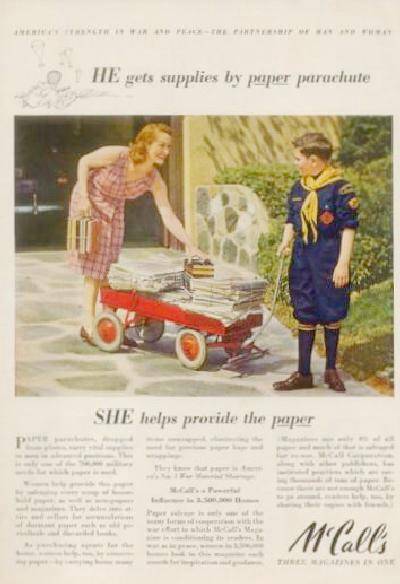
Figure 1.--This is a 1945 print ad from McCall's magazine, with a photo of a Cub Scout collecting paper for recycling. More than 0.7 million Scouts and Cubs participated |

|
The most important drives ocurred early in the War. The rubber drive was particularly important. There were many other drives , including paper drives. The Federal Goernment estimated early in the War that 20 million tons of paper would be needed fo the War. They thought that 7 million ttons could come from salvage drives. The paper collected at first hadnít actually been needed. And quantities had been collected far exceeding what was needed. This began to change by 1943 when planners forcast increased needs in 1944. This varied regionally depending on the needs of local factories. Two factors affected the requirements for paper. The production of virgin pulpwood was declining, in large part because of labor shortages. In addition, military requirements were escalatng. Paper is not an item strongly associated with the military, but in fact the military used prodigeous quantities of papaper and papr products like cardboard boxes. The Federal War Production Board (WPB) estimated that 30,000 tons of paperboard were needed monthly just to pack artllery shells. Carons were needed for K-ration cartons, canned food, and a myriad list of other items. Special containers were made for items like blood plasma. A carload of blue print paper was needed to draw the plans for capital ships like battleships and carries. The army reported that more than 1 million paper milk cartons were used daily in its camps. The biggest problem in collecting newspapers was that the Government was attempting to reduce gasoline consumption through rationing. Thus collecting newspapers could increase consumption of a much more vital resource--petroleum. And becuse of the quanities involved, an emormous collecton effort was needed. Here schools, the Boy Scouts, and other groyps played major roles.
The most important drives ocurred early in the War. The rubber drive was particularly important. There were many other drives , including paper drives. The Federal Government estimated early in the War that 20 million tons of paper would be needed fo the War. They thought that 7 million tons could come from salvage drives.
The paper collected at first hadnít actually been needed. And quantities had been collected far exceeding what was needed.
The paper situation began to change by 1943 when planners forcast increased needs in 1944. WPB Chairman Donald M. Nelson warned that "the shortage of wood pulp and available waste paper at the paper mills is becoming increasingly critical. The demands of the mills for paperboard containers and paper products for shipment of supplies to all battlefronts is growing constantly." [Paper Trooper] This varied regionally depending on the needs of local factories. Two factors affected the requirements for paper. The production of virgin pulpwood was declining, in large part because of labor shortages. In addition, military requirements were escalatng.
Paper is not an item strongly associated with the military, but in fact the military used prodigeous quantities of papaper and papr products like cardboard boxes. The Federal War Production Board (WPB) estimated that 30,000 tons of paperboard were needed monthly just to pack artllery shells. Cartons were needed for K-ration cartons, canned food, and a myriad list of other items. Special containers were made for items like blood plasma. A carload of blue print paper was needed to draw the plans for capital ships like battleships and carries. The army reported that more than 1 million paper milk cartons were used daily in its camps.
The biggest problem in collecting newspapers was that the Government was attempting to reduce gasoline consumption through rationing. Thus collecting newspapers could increase consumption of a much more vital resource--petroleum. And becuse of the quanities involved, an emormous collecton effort was needed. Here schools played an important role. Some schools had Paper Trooper programs. The WPB studied school paper drives and cme up with an efficent system hich they named Paper Troopers. The Boy Scouts, and other groups also played major roles. Scout Troops began collecting paper even before the War began. General Dwight D. Eisenhower's outstanding Wastepaper Campaign culminates in the General Eisenhower Award. The largest single war-effort project conducted by the Boy Scouts was the 1945 General Dwight D. Eisenhower Waste Paper Campaign. More than 0.7 million Boy Scouts and Cubs participated. The Boy Scouts presented a gold medal to Eisenhower in appreciation (December 1945).
O'Neill, William L. Democracy at War.
"Use of Reclaimed Salvage" Memorandum, circa March 1942. Folder 13, Box 28, Defense Council Records, OSA.
"Paper Trooper: A Manual for School Administrators and Community Leaders," U.S. War Production Board, circa 1944. Folder 9, Box 30, Defense Council Records, OSA.
Navigate the Historic Boys' Uniform Chronology Pages:
[Return to the Main chronologies page]
[The 1900s]
[The 1910s]
[The 1920s]
[The 1930s]
[The 1940s]
[The 1950s]
[The 1960s]
[The 1970s]
[The 1980s]
[The 1990s]
[The 2000s]
Navigate the Historic Boys' Uniform Web Site:
[Return to the Main U.S. Scout World War II activities page ]
[Return to the Main uniform chronologies page]
[Return to the Main U.S. youth group war activity page]
[Activities]
[Biographies]
[Chronologies]
[Countries]
[Essays]
[Garments]
[Organizations]
[Religion]
[Other]
[Introduction]
[Bibliographies]
[Contributions]
[FAQs]
[Questions]
[Unknown images]
[Boys' Uniform Home]
Navigate the Historic Boys' Uniform Web organizatiion pages:
[Return to the Main U.S. Scout page]
[Return to the National Scout page]
[Boys' Brigade]
[Camp Fire]
[Hitler Youth]
[National]
[Pioneers]
[Royal Rangers]
[Scout]
